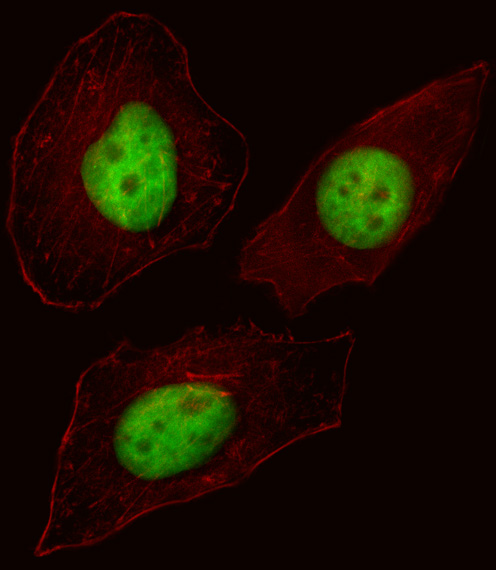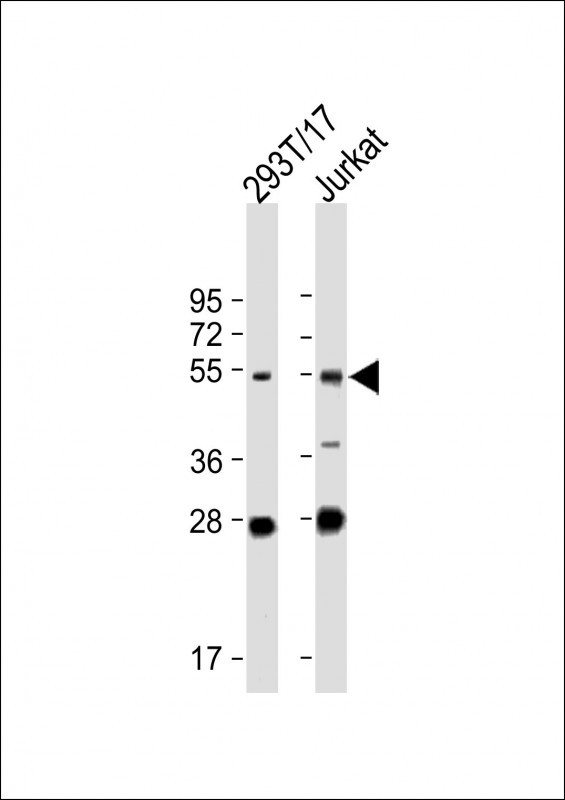FOXN3 Antibody (C-term)
Affinity Purified Rabbit Polyclonal Antibody (Pab)
- SPECIFICATION
- CITATIONS: 4
- PROTOCOLS
- BACKGROUND

Application
| WB, IF, E |
|---|---|
| Primary Accession | O00409 |
| Other Accession | NP_005188.2 |
| Reactivity | Human |
| Host | Rabbit |
| Clonality | Polyclonal |
| Isotype | Rabbit IgG |
| Calculated MW | 53835 Da |
| Antigen Region | 380-408 aa |
| Gene ID | 1112 |
|---|---|
| Other Names | Forkhead box protein N3, Checkpoint suppressor 1, FOXN3, C14orf116, CHES1 |
| Target/Specificity | This FOXN3 antibody is generated from rabbits immunized with a KLH conjugated synthetic peptide between 380-408 amino acids from the C-terminal region of human FOXN3. |
| Dilution | WB~~1:2000 IF~~1:10~50 E~~Use at an assay dependent concentration. |
| Format | Purified polyclonal antibody supplied in PBS with 0.09% (W/V) sodium azide. This antibody is purified through a protein A column, followed by peptide affinity purification. |
| Storage | Maintain refrigerated at 2-8°C for up to 2 weeks. For long term storage store at -20°C in small aliquots to prevent freeze-thaw cycles. |
| Precautions | FOXN3 Antibody (C-term) is for research use only and not for use in diagnostic or therapeutic procedures. |
| Name | FOXN3 |
|---|---|
| Synonyms | C14orf116, CHES1 |
| Function | Acts as a transcriptional repressor. May be involved in DNA damage-inducible cell cycle arrests (checkpoints). |
| Cellular Location | Nucleus. |

Provided below are standard protocols that you may find useful for product applications.
Background
This gene is a member of the forkhead/winged helix transcription factor family. Checkpoints are eukaryotic DNA damage-inducible cell cycle arrests at G1 and G2. Checkpoint suppressor 1 suppresses multiple yeast checkpoint mutations including mec1, rad9, rad53 and dun1 by activating a MEC1-independent checkpoint pathway. Alternative splicing is observed at the locus, resulting in distinct isoforms. [provided by RefSeq].
References
Samaan, G., et al. Biochem. Biophys. Res. Commun. 400(1):60-65(2010)
Rose, J.E., et al. Mol. Med. 16 (7-8), 247-253 (2010) :
Jugessur, A., et al. PLoS ONE 5 (7), E11493 (2010) :
Markowski, J., et al. Eur Arch Otorhinolaryngol 266(10):1501-1507(2009)
Schlade-Bartusiak, K., et al. Am. J. Med. Genet. A 146A (1), 117-123 (2008) :
If you have used an Abcepta product and would like to share how it has performed, please click on the "Submit Review" button and provide the requested information. Our staff will examine and post your review and contact you if needed.
If you have any additional inquiries please email technical services at tech@abcepta.com.














 Foundational characteristics of cancer include proliferation, angiogenesis, migration, evasion of apoptosis, and cellular immortality. Find key markers for these cellular processes and antibodies to detect them.
Foundational characteristics of cancer include proliferation, angiogenesis, migration, evasion of apoptosis, and cellular immortality. Find key markers for these cellular processes and antibodies to detect them. The SUMOplot™ Analysis Program predicts and scores sumoylation sites in your protein. SUMOylation is a post-translational modification involved in various cellular processes, such as nuclear-cytosolic transport, transcriptional regulation, apoptosis, protein stability, response to stress, and progression through the cell cycle.
The SUMOplot™ Analysis Program predicts and scores sumoylation sites in your protein. SUMOylation is a post-translational modification involved in various cellular processes, such as nuclear-cytosolic transport, transcriptional regulation, apoptosis, protein stability, response to stress, and progression through the cell cycle. The Autophagy Receptor Motif Plotter predicts and scores autophagy receptor binding sites in your protein. Identifying proteins connected to this pathway is critical to understanding the role of autophagy in physiological as well as pathological processes such as development, differentiation, neurodegenerative diseases, stress, infection, and cancer.
The Autophagy Receptor Motif Plotter predicts and scores autophagy receptor binding sites in your protein. Identifying proteins connected to this pathway is critical to understanding the role of autophagy in physiological as well as pathological processes such as development, differentiation, neurodegenerative diseases, stress, infection, and cancer.


